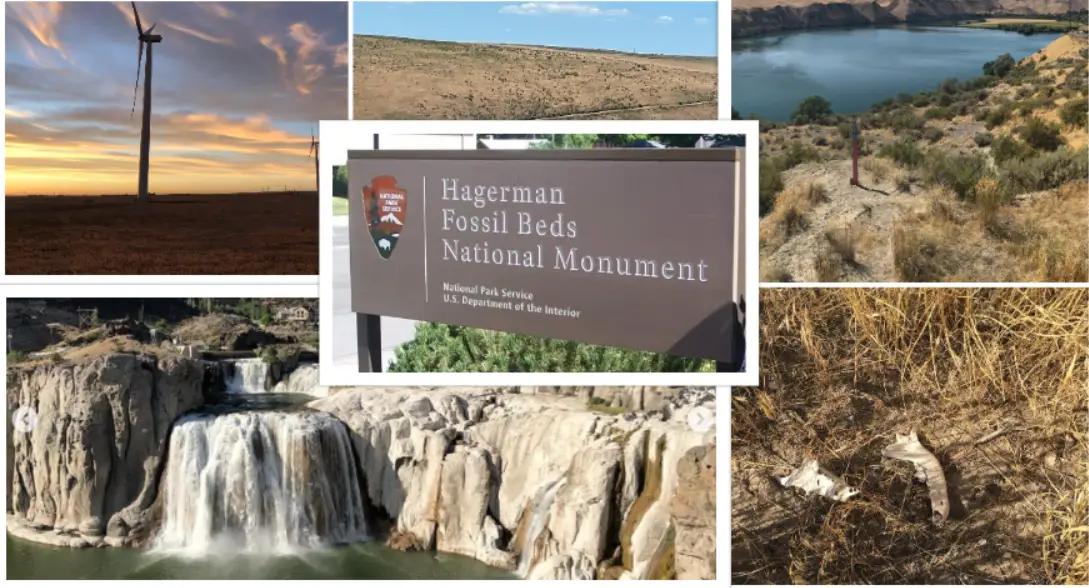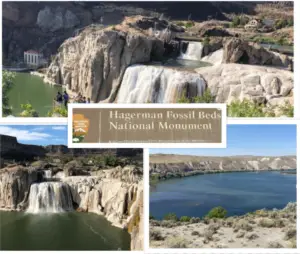Hagerman Fossil Beds National Monument : Interesting Facts, History & Travel Guide

- By
- Aparna Patel
- |
- 1 Apr, 2023
- |

If you’re a fan of natural history and paleontology, then Hagerman Fossil Beds National Monument is a must-see destination. Located in Idaho, the monument is home to a fascinating collection of fossils, including the famous Hagerman Horse. But there’s more to the monument than just fossils, with beautiful hiking trails, ranger-led programs, and abundant wildlife to discover.
In this blog, we’ll take a closer look at the history and geology of Hagerman Fossil Beds National Monument, share some interesting facts, and provide a travel guide to help you plan your visit. Whether you’re a science enthusiast, nature lover, or just looking for a unique adventure, Hagerman Fossil Beds National Monument has something for everyone.
- Hagerman Fossil Beds National Monument is located in southwestern Idaho, USA, and covers over 4,300 acres.
- The monument contains one of the richest fossil deposits from the late Pliocene epoch, approximately 3 to 4 million years ago.
- The fossils found in the monument include over 200 species of plants and animals, many of which are now extinct.
- The most famous fossil found in the Hagerman Fossil Beds is the Hagerman Horse, which was discovered in 1928 and is the state fossil of Idaho.
- The Hagerman Fossil Beds were formed when the area was covered by a large lake that existed during the late Pliocene epoch.
- The monument is home to a diverse range of wildlife, including elk, deer, coyotes, and over 150 species of birds.
- Visitors can explore the monument through hiking trails, ranger-led programs, and a visitor center that features exhibits on the geology, paleontology, and natural history of the area.
- The monument was established as a National Natural Landmark in 1975 and designated as a national monument in 1988 by President Ronald Reagan.
- The Hagerman Fossil Beds are a valuable resource for scientists studying the evolution and ecology of the late Pliocene epoch, providing important insights into the past climate and ecosystems of the region.
- The Hagerman Fossil Beds National Monument is one of only two national monuments in Idaho, the other being Craters of the Moon National Monument and Preserve.
Read More:
- Grand Staircase–Escalante National Monument : Interesting Facts, History & Travel Guide
- Grand Portage National Monument : Interesting Facts, History & Travel Guide
- Grand Canyon–Parashant National Monument : Interesting Facts, History & Travel Guide
- Governors Island National Monument : Interesting Facts, History & Travel Guide
Information & History of Hagerman Fossil Beds National Monument
During the late Pliocene epoch, the area was covered by a large lake known as Lake Idaho. Over time, sediment from nearby mountains flowed into the lake and formed layers of sediment that eventually buried the remains of plants and animals that lived in the area. These remains were fossilized over time, creating the rich fossil deposits that are now found in the monument.
The most famous fossil found in the Hagerman Fossil Beds is the Hagerman Horse, which was discovered in 1928 by a local schoolteacher. The Hagerman Horse was a small, three-toed horse that is now extinct. Other fossils found in the monument include camels, mastodons, and giant ground sloths.
The area that is now the Hagerman Fossil Beds National Monument was originally managed by the Bureau of Land Management. In 1975, the area was designated as a National Natural Landmark, recognizing the importance of the fossil deposits found in the area. In 1988, the monument was established by an act of Congress and signed into law by President Ronald Reagan.
Today, the Hagerman Fossil Beds National Monument is a popular destination for visitors interested in the area’s natural history and geology. Visitors can explore the monument through hiking trails, ranger-led programs, and exhibits at the visitor center. The monument also provides important research opportunities for scientists studying the evolution and ecology of the late Pliocene epoch.
Travel Guide for Hagerman Fossil Beds National Monument
- Visitor Center: Start your visit at the Hagerman Fossil Beds National Monument Visitor Center, which features exhibits on the geology, paleontology, and natural history of the area. The visitor center also has a gift shop where you can purchase souvenirs and educational materials.
- Hiking Trails: There are several hiking trails in the monument that offer stunning views of the surrounding landscape and opportunities to see fossils in their natural setting. The Box Canyon Trail is a popular option, as it offers views of the Snake River Canyon and the chance to see fossils along the way.
- Ranger-Led Programs: The monument offers a variety of ranger-led programs, including guided hikes and educational programs for kids. Check the park’s website or ask at the visitor center for a schedule of upcoming programs.
- Camping: There are no campgrounds within the monument, but there are several nearby campgrounds that offer camping options, including the Hagerman City Park Campground and the Thousand Springs State Park.
- Wildlife Watching: The Hagerman Fossil Beds National Monument is home to a diverse range of wildlife, including elk, deer, coyotes, and over 150 species of birds. Be sure to bring binoculars and a camera to capture the wildlife in their natural habitat.
- Nearby Attractions: If you have extra time, consider exploring some of the other nearby attractions, such as Thousand Springs State Park or the City of Rocks National Reserve.
- Weather: The weather in Hagerman Fossil Beds National Monument can vary greatly depending on the season, with hot summers and cold winters. Be sure to check the weather forecast and bring appropriate clothing and gear for your visit.
By following these tips, you can make the most of your visit to Hagerman Fossil Beds National Monument and experience the natural wonder and rich history of this unique area.
More Articles:
- Gold Butte National Monument : Interesting Facts, History & Travel Guide
- Gila Cliff Dwellings National Monument : Interesting Facts, History & Travel Guide
- Giant Sequoia National Monument : Interesting Facts, History & Travel Guide
- George Washington Carver National Monument : Interesting Facts, History & Travel Guide
- Freedom Riders National Monument : Interesting Facts, History & Travel Guide
- Fossil Butte National Monument : Interesting Facts, History & Travel Guide
- Fort Union National Monument : Interesting Facts, History & Travel Guide
Some frequently asked questions about Hagerman Fossil Beds National Monument:
What kind of fossils can be found at Hagerman Fossil Beds National Monument?
The area is most famous for the fossils of the Hagerman Horse, but other fossils found in the monument include camels, mastodons, and giant ground sloths.
How was the Hagerman Fossil Beds National Monument established?
The monument was established by an act of Congress in 1988 and signed into law by President Ronald Reagan. Prior to that, the area was managed by the Bureau of Land Management.
What is there to do at Hagerman Fossil Beds National Monument?
Visitors can explore the monument through hiking trails, ranger-led programs, and exhibits at the visitor center. The area is also popular for wildlife watching and camping.
Is there camping available within the monument?
No, there are no campgrounds within the monument. However, there are several nearby campgrounds that offer camping options.
What is the weather like at Hagerman Fossil Beds National Monument?
The weather in Hagerman Fossil Beds National Monument can vary greatly depending on the season, with hot summers and cold winters. Be sure to check the weather forecast and bring appropriate clothing and gear for your visit.
Can I collect fossils at Hagerman Fossil Beds National Monument?
No, it is illegal to collect fossils or other natural resources from national monuments and parks. Visitors are encouraged to leave the fossils in their natural setting for others to enjoy.
Search Posts
Latest posts
-
4 Mar, 2024
How can I do a "broad" search for flights?
-
4 Mar, 2024
How to make dining alone less awkward?
Popular posts
-
5 Mar, 2024
Why prohibit engine braking?
